Phonautograph lecture
Intro
Gramophone is not your run-of-the-mill history of recorded sound. There's so much weird, eccentric detail in Kittler's writing, in fact, that it can be overwhelming for a first-time reader; moreover, his matter-of-fact style and emphasis on strange historical facts may cloud over the basic argument of his work. I wrote this mini-lecture to dig a bit into Kittler's argument and to clarify some of the historical details that are essential to it. As is our style, the lecture will involve some questionable experiments, which we hope work.
Recap
Let's start with a recap of Yoni's lecture last Tuesday. Yoni argued that, as an inventor, Edison had it pretty easy, because all he had to do was put together a bunch of materials that were just lying around the late 19th century. To refresh your memory, the gramophone parts include the stylus (or needle), a vibrating diaphragm, a mechanical crank, a horn, a rotating cylinder, and some tinfoil to record on:
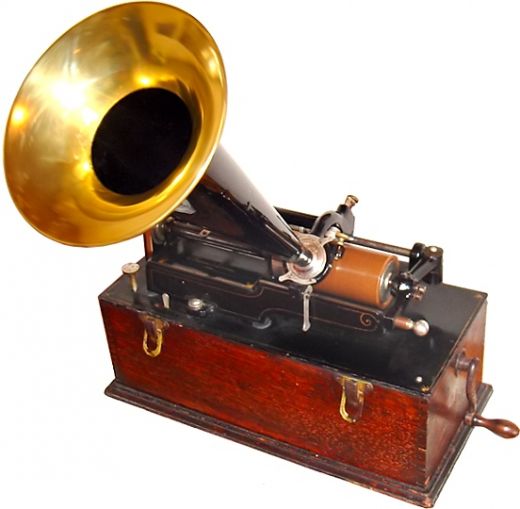
An Edison phonograph. Image credit: Wikipedia Commons.
- The stylus dates back to the invention of writing. The ancient Greeks started writing things down in the 8th or 9th century BC—almost three thousand years ago. [1]
- Artificial sound amplification dates back at least to the Romans. The Roman engineer Vitruvius, born around the time of Christ, described bronze "sounding vessels" to amplify the voices of actors in the theater. [2] Sixteen centuries later—but still well before Edison—a French Jesuit priest wrote a mathematics text in which he described an ear trumpet. [3] Another Jesuit priest, Athanasius Kircher, invented the speaking trumpet around the same time. [4]
- Tinfoil actually isn't that old, but was in common use by Edison's time. [5]
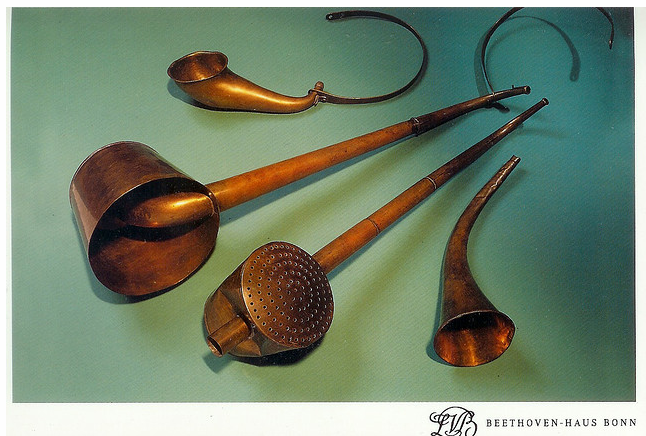
Beethoven's ear trumpets. [6]
| [1] | See http://en.wikipedia.org/wiki/Greek_alphabet |
| [2] | Lindsay, Acoustics: Historical and Philosophical Development, 143 |
| [3] | See http://en.wikipedia.org/wiki/Ear_trumpet |
| [4] | http://www.flickr.com/photos/sugarpacketchad/2166653479/ |
| [5] | See The Penny cyclopædia of the Society for the Diffusion of Useful Knowledge, 322 (http://books.google.com/books?id=acwGAAAAYAAJ&pg) |
| [6] | http://en.wikipedia.org/wiki/Tin_foil |
With all these materials available, Yoni suggested that it was almost inevitable that someone would put them together to invent the gramophone. In retrospect, it certainly seems like an obvious thing to do.
But what's remarkable about the gramophone is not only that anyone at the end of the nineteenth century could build one out of materials that were, for the most part, just lying around. It takes more than a clever combination of materials to make an invention that changes the world. More fundamentally, it takes a radical conceptual leap—one that even Edison himself couldn't fully grasp, despite being the inventor. Recall, first, that the discovery of the phonograph was acciental: Edison was working on telephone improvements. Second, remember the weird ideas Edison had about how his new invention should be used. In his list of uses for the phonograph, the reproduction of music appeared fourth, below dictation, phonographic books, and the teaching of elocution, in other words, he was thinking about the gramophone mostly as a replacement of old technologies of speech transcription, rather than as a radical innovation.
Of course, Edison can't be blamed for a lack of foresight with regards to his own invention. What's obvious to us, with our iPods and YouTube music videos, wasn't at all clear to those who lived in a world in which the dominant medium was written text. It may be impossible to conceive of this world, even though it existed not too long ago. But with a little help, we might be able to imagine it. In 1896, the Lumière brothers, pioneers of cinema, played their short film of a train arriving at a station to an audience that panicked, thinking that the projection was real and coming straight at them:
http://www.youtube.com/watch?v=1dgLEDdFddk
As media-immersed twenty-first century students, we can only imagine their profound terror, not to mention that of the first people in history to hear the reproduction of their own disembodied voices, the voices of the dead, and—of course—music.
"Old Europe's" music-writing: the monochord, interval ratios, pitch letters
This is where Kittler comes in. We like Kittler's Gramophone because it helps us understand the gramophone's radical novelty. Also, as composers, it can help us think about the difference between different types of music writing and reproduction: on one hand, traditional music notation, which involves notes and interval ratios; on the other, the gramophone's inscription and playback of sound waves. Kittler argues that the conceptual difference between the two is vast:
Overtones are frequencies, that is, vibartions per second. And the grooves of Edison's phonograph recorded nothing but vibrations. Intervals and chords, by contrast, were ratios, that is, fractions made up of integers. The length of a string (especially on a monochord) was subdivided, and the fractions, to which Pythagoras gave the proud name logoi, resulted in octaves, fifths, fourths, and so on. Such was the logic upon which was founded everything that, in Old Europe, went by the name of music: first, there was a notation system that enabled the transcription of clear sounds separated from the world's noise; and second, a harmony of the spheres that established that the ratios between planetary orbits (later human souls) equaled those between sounds. [7]
| [7] | Kittler, GFT, 24. |
What is Kittler talking about here?
"Intervals and chords...were ratios." Experiment 1: Using the electric guitar (i.e. "monochord") to demonstrate harmonic ratios of the octave, fifth, and fourth.
- Shortening the string by 1/2 produces an octave (interval ratio 1:2 or 2:1)
- Shortening the string by 1/3 (leaving 2/3) produces a perfect fifth (ratio 2:3 or 3:2)
- Shortening the string by 1/4 (leaving 3/4) produces a perfect fourth (ratio 3:4 or 4:3)
- Try it out yourself on a guitar, and see http://en.wikipedia.org/wiki/Interval_(music)#Frequency_ratios and http://en.wikipedia.org/wiki/Just_intonation for more info; we'll talk more about interval ratios later in the semester.
"Harmony of the spheres"
Note the link between string divisions (expressed as proportions to the left and right of the monochord) and the letter names of the musical scale.
- Proportio dupla = 2:1 = octave between low G (Γ = Greek letter
gamma) and G = diapason (Greek name for the octave)
Prop. sesquitertia = 4:3 = fourth between low G and C = diatessaron
Prop. sesquialtera = 3:2 = fifth between G and d = diapente
Also note the symbolism of the elements, zodiac signs, hand of God, etc.
(Kittler is using the "harmony of the spheres" to make fun of the symbolic worldview.)
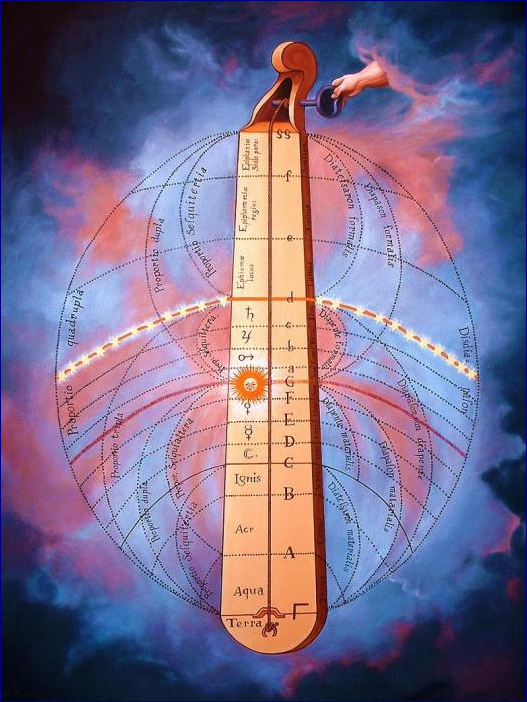
Image of Robert Fludd's "celestial monochord" from 1618, as painted by Maugdo Vasquez. [8]
| [8] | http://fineartamerica.com/featured/the-divine-monochord-maugdo-vasquez.html |
- "Clear sounds separated from the world's noise": Pythagorean
emphasis on the relationship between consonant harmonies and small
number interval ratios. Weird (i.e. dissonant) ratios are excluded
from representation, to say nothing of noises that vary
chaotically over time.
- How do you notate wind noise, vocal noise, etc. in traditional music notation?
Nineteenth-century "sound writing" and the phonautograph
Kittler continues:
The nineteenth century's concept of frequency breaks with all this. The measure of length is replaced by time as an independent variable. It is a physical time removed from the meters and rhythms of music. It quantifies movemens that are too fast for the human eye, ranging from 20 to 16000 vibrations per second. The real takes the place of the symbolic. Certainly, references can also be established to link musical intervals and acoustic frequencies, but they only testify to the distance between two discourses. In frequency curves the simple proportions of Pythagorean music turn into irrational, that is, logarithmic, functions. Conversely, overtone series—which in frequency curves are simply integral [25] multiples of vibrations and the determining elements of each sound—soon explode the diatonic music system. That is the depth of the gulf separating Old European alphabetism from mathematical-physical notation.
Kittler then gives a brief history of frequency notation, which, as he emphasizes, "developed outside of music" in scientific discourse (composer's didn't seem too interested...), and included such weird science as talking dolls, elastic tongues connected to cogwheels, and a pig's bristle that etches the vibrations of a tuning fork on a glass plate. The next development was an invention called the phonautograph, which is worth exploring in depth to understand just how fickle the history of science can be. Kittler writes:
From Weber's writing tuning fork Edouard Léon Scott, who as a Parisian printer was, not coincidentally, an inhabitant of the Gutenberg Galaxy, developed his phonautograph, patented in 1857. A bell-mount amplified incoming sounds and transmitted them onto a membrane, which in turn used a coarse bristle to transcribe them onto a soot-covered cylinder. Thus came into being autographs or handwritings of a data stream that heretofore had not ceased not to write itself. (Instead, there was handwriting.) Scott's phonautograph, however, made visible what, up to this point, had only been audible and had been much too fast for ill-equipped [27] human eyes: hundreds of vibrations per second. A triumph of the concept of frequency: all the whispered or screamed noises people emitted from their larynxes, with or without dialects, appeared on paper. Phonetics and speech physiology became a reality.
- Experiment 2: a twenty-first-century simulation of a
nineteenth-century technology.
- Equipment list:
- amplified electric guitar
- ebow
- a transducer with a pencil taped to it
- a record player with a piece of paper taped to the rotating part
- Equipment list:
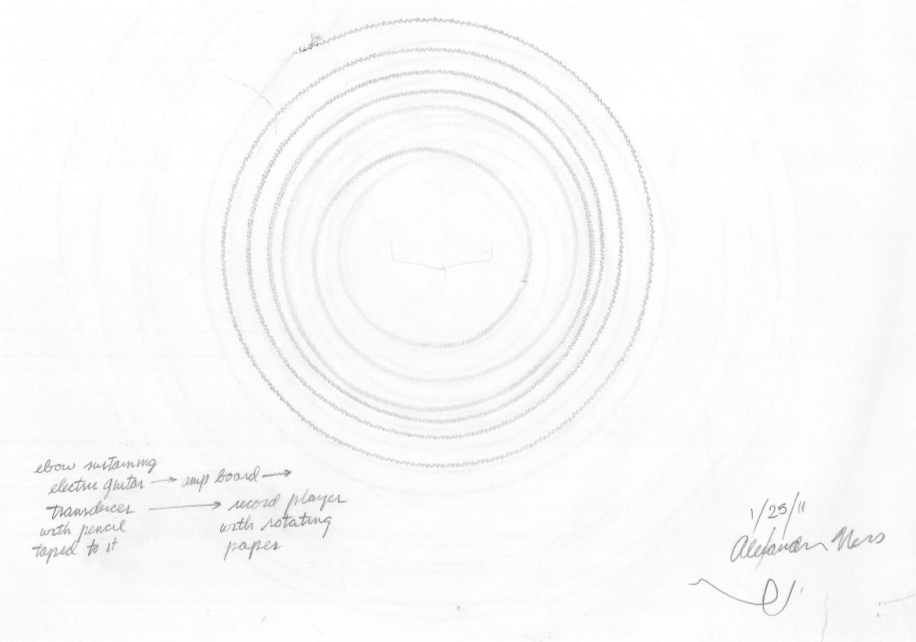
A drawing from our phonautograph.
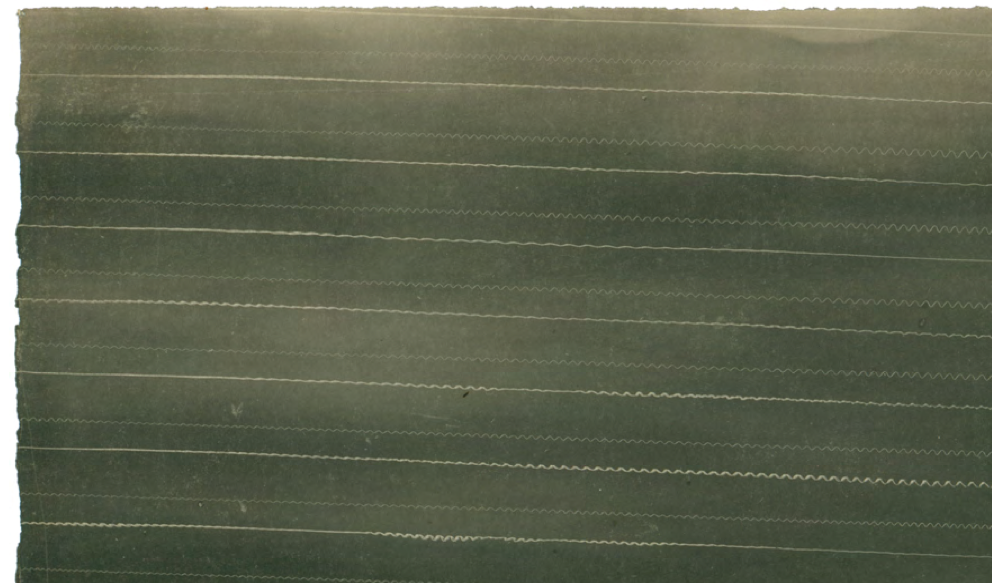
A drawing from Scott's phonautograph. [9]
| [9] | From Fixation et Transcription du Chant (1860), 6. PDF online: http://www.firstsounds.org/publications/facsimiles/FirstSounds_Facsimile_05.pdf |
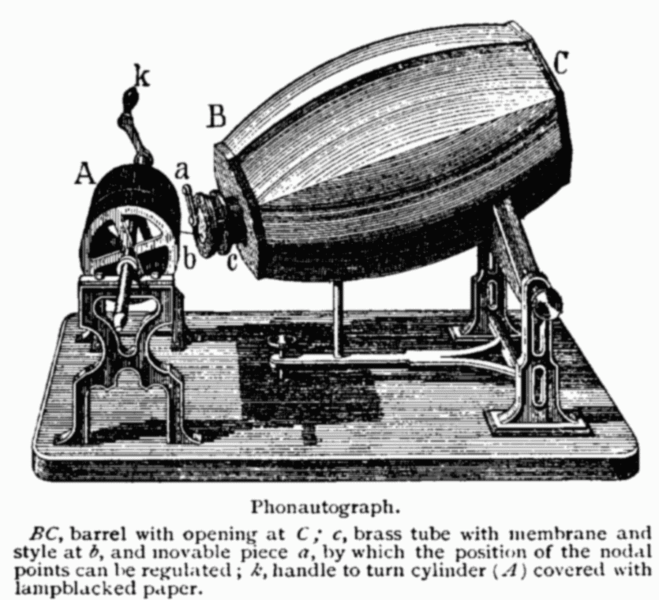
A diagram of the phonautograph.
Since the phonautograph, sound data streams have "not ceased not to write themselves" (i.e. they continue to write themselves). But Scott lacked Edison's conceptual foresight. Despite his contribution to the history of sound media, he was still thinking of frequency scribblings as documents for human eyes to read, rather than for a machine to reproduce. A quote from his text submitted to the Académie des Sciences de l’Institut de France demonstrates his "Old European" instinct to make (symbolic) visual sense out of new media:
I am engaged in studying by sight the difference of sounds and noises, in solving one part of the mystery of the numerical harmony of agitations which is established in animate and inanimate bodies under the influence of a prolonged sound. [10]
| [10] | The Phonautographic Manuscripts of Édouard-Léon Scott de Martinville, 6. PDF online: http://www.firstsounds.org/public/Phonautographic-Manuscripts.pdf) |
Aside: While the muses of media history were less kind to Scott than to Edison, however, Scott may get the last laugh, or at least a chuckle. Modern computer technology makes possible what Scott was unable even to imagine: the sonic reproduction of his delicate etchings in soot:
http://firstsounds.org/sounds/scott.php
If Kittler is right, then the innovation of the gramophone was as much conceptual as technological. The gramophone and sound recording in general may not complement or augment notation, as much as it presents a radical alternative to it. ...
This document was generated on 2011-12-20 at 14:07.